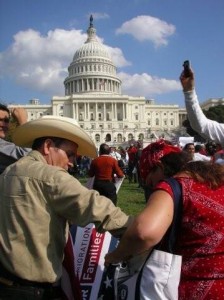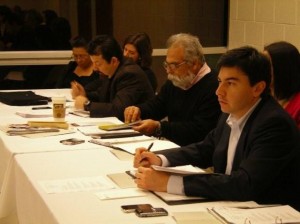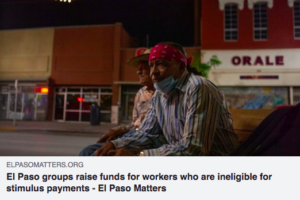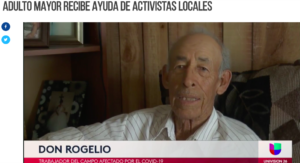Early 1990s: The Genesis
A group of dedicated El Paso attorneys and civil rights activists created the Border Rights Coalition in the early 1990s, with support from the American Friends Service Committee through its Immigration Law Enforcement Monitoring Project. The group documented alleged human rights and civil rights abuses committed by the Border Patrol and provided legal aid to the community on specific cases.
The highlight of the work of the Border Rights Coalition was the group’s involvement in two landmark cases – The historic civil federal lawsuit brought by the students and staff of Bowie High School in 1992 to stop the Border Patrol from harassing students inside the school; and the 1997 death of Esequiel Hernandez Jr., a teenage goat herder who was killed by Marines patrolling the border near Redford, Texas.
Principios de la decada de 1990: El Genesis
Un grupo de abogados dedicados de El Paso y activistas de los derechos civiles crearon la Coalición de Derechos Fronterizos a principios de la década de 1990, con el apoyo del Comité de Servicio de Amigos Estadounidenses a través de su Proyecto de Monitoreo de la Aplicación de la Ley de Inmigración. El grupo documentó presuntos abusos contra los derechos humanos y los derechos civiles cometidos por la Patrulla Fronteriza y brindó asistencia legal a la comunidad en casos específicos.
Lo más destacado del trabajo de la Border Rights Coalition fue la participación del grupo en dos casos históricos: la histórica demanda civil federal presentada por los estudiantes y el personal de Bowie High School en 1992 para evitar que la Patrulla Fronteriza hostigara a los estudiantes dentro de la escuela; y la muerte en 1997 de Esequiel Hernandez Jr., un pastor de cabras adolescente que fue asesinado por marines que patrullaban la frontera cerca de Redford, Texas.
1998: Back to the Roots
The Border Rights Coalition began transforming itself into a grassroots organization with the hiring of Fernando Garcia as executive director. Garcia, a former photojournalist in California, said that despite high profile cases such as the Bowie High School suit, abuses of civil and human rights continued in El Paso, mostly in the form of possible illegal entry by the Border Patrol, racial profiling and alleged beatings.
Garcia started training community members as Human Rights Promoters to teach their neighbors about search warrants, their right to remain silent and other civil and human rights they did not know they had. The strategy to have trusted members of the community train others – was successful.
Later, community members organized themselves into Human Rights Committees, meeting weekly to discuss cases and organize events. Some of the groups have been meeting continuously since 2000. In 2000, the Border Network for Human Rights (the name changed legally in 2001) had its first abuse documentation campaign conducted by members of the community, with support from immigration and human rights lawyers.
1990: Volviendo a las Raíces
La Coalición por los Derechos Fronterizos comenzó a transformarse en una organización de base con la contratación de Fernando García como director ejecutivo. García, un ex reportero gráfico en California, dijo que a pesar de los casos de alto perfil como la demanda de la Escuela Secundaria Bowie, los abusos de los derechos civiles y humanos continuaron en El Paso, principalmente en forma de posible entrada ilegal de la Patrulla Fronteriza, perfilado racial y presunto palizas.
García comenzó a capacitar a miembros de la comunidad como Promotores de Derechos Humanos para enseñar a sus vecinos acerca de las órdenes de allanamiento, su derecho a permanecer en silencio y otros derechos civiles y humanos que no sabían que tenían. La estrategia de hacer que miembros confiables de la comunidad capaciten a otros fue exitosa.
Más tarde, los miembros de la comunidad se organizaron en Comités de Derechos Humanos, reuniéndose semanalmente para discutir casos y organizar eventos. Algunos de los grupos se han estado reuniendo continuamente desde 2000. En 2000, la Red Fronteriza por los Derechos Humanos (el nombre cambió legalmente en 2001) tuvo su primera campaña de documentación de abusos realizada por miembros de la comunidad, con el apoyo de abogados de inmigración y derechos humanos.
2003: Going public
After three years of intense organizing, during which membership grew exponentially to reach hundreds of people, the Border Network for Human Rights held its first public event. It was prompted by the tragic death of Juan Patricio Peraza Quijada on February 22, 2003. Juan Patricio, a 19-year-old undocumented immigrant, was shot and killed by Border Patrol agents outside the migrants’ shelter where he was staying. The Border Network for Human Rights organized a 20-mile march, from Anthony to Downtown El Paso, to honor Juan Patricio and demand accountability from the Border Patrol. Hundreds of men, women and children participated in the event.
In addition to public events, the Border Network for Human Rights started sending delegations to Washington, D.C., each year to educate elected officials about the realities of border life and the need for immigration reform. These trips also served to introduce members of the community to the realities of the U.S. political system.
2003: Saliendo al Publico
Después de tres años de intensa organización, durante los cuales la membresía creció exponencialmente para llegar a cientos de personas, la Red Fronteriza por los Derechos Humanos realizó su primer evento público. Fue provocado por la trágica muerte de Juan Patricio Peraza Quijada el 22 de febrero de 2003. Juan Patricio, un inmigrante indocumentado de 19 años, fue asesinado a tiros por agentes de la Patrulla Fronteriza afuera del refugio para migrantes donde se hospedaba. La Red Fronteriza por los Derechos Humanos organizó una marcha de 20 millas, desde Anthony hasta el centro de El Paso, para honrar a Juan Patricio y exigir responsabilidad a la Patrulla Fronteriza. Cientos de hombres, mujeres y niños participaron en el evento.
Además de los eventos públicos, la Red Fronteriza por los Derechos Humanos comenzó a enviar delegaciones a Washington, D.C. cada año para educar a los funcionarios electos sobre las realidades de la vida en la frontera y la necesidad de Reforma Migratoria. Estos viajes también sirvieron para presentar a los miembros de la comunidad las realidades del sistema político estadounidense.
2005: A time for responsible law enforcement
In 2005, the Border Network for Human Rights responded to a situation where long-time El Paso Sheriff Leo Samaniego had his deputies detain undocumented immigrants, thereby sowing fear in the community. After a campaign including the drafting and eventual adoption of a resolution by county commissioners calling for the end of the practice, Samaniego ceased.
At that time, the Border Network for Human Rights started making allies with law enforcement officials who believe mixing immigration and criminal enforcement is bad policy. The Border Network for Human Rights also organized a series of joint community meetings with the Border Patrol, during which then-Border Patrol Sector Chief Luis Barker took questions from community members.
2005: Tiempo para un cumplimiento de la ley responsabre
En 2005, la Red Fronteriza por los Derechos Humanos respondió a una situación en la que el antiguo alguacil de El Paso, Leo Samaniego, hizo que sus ayudantes detuvieran a inmigrantes indocumentados, lo que sembró el miedo en la comunidad. Después de una campaña que incluyó la redacción y eventual adopción de una resolución por parte de los comisionados del condado que pedían el fin de la práctica, Samaniego cesó.
En ese momento, la Red Fronteriza por los Derechos Humanos comenzó a aliarse con los funcionarios encargados de hacer cumplir la ley que creen que mezclar inmigración y control criminal es una mala política. La Red Fronteriza por los Derechos Humanos también organizó una serie de reuniones comunitarias conjuntas con la Patrulla Fronteriza, durante las cuales el entonces Jefe de Sector de la Patrulla Fronteriza, Luis Barker, respondió preguntas de los miembros de la comunidad.
2006: Immigration reform
In December 2005, U.S. Rep. James Sensenbrenner, (R-WI), introduced the Border Protection, Antiterrorism, and Illegal Immigration Control Act of 2005 (H.R. 4437), a needlessly punitive bill, and the struggle for humane and rational immigration reform was born. Immigrant communities and their supporters organized massive street protests around the nation in 2006. The Border Network for Human Rights was one of the leaders of this mobilization with marches in March, April and May 2006 that brought tens of thousands of El Pasoans to the streets.
2006: Reforma Migratoria
En Diciembre 2005, el Rep. James Sensenbrenner, (R-WI) de los U.S. presento la “Ley de protección fronteriza, antiterrorismo y control de la imigración ilegal del 2005 (H.R. 4437), un proyecto de ley innecesariamente punitivo, y asi nació la lucha por una refprma migratoria humana y racional. Las comunidades de inmigrantes y simpatizantes organizaron protestas callejeras masivas en todo el pais en el 2006. La Red Fronteriza por los Derechos Humanos fue uno de los líderes de la movilizacion con marchas en marzo, abril y mayo del 2006 que sacaron la la calle a decenas de miles de habitantes de El Paso.
2007: Working to change the system
The Border Network for Human Rights continued working on immigration reform in 2007 with letter-writing campaigns and forum discussions aiming at including the voices of border communities in the national debate. Through the staff’s hard work, several elements proposed by the Border Network for Human Rights (such as the creation of a U.S.-Mexico border enforcement review commission, more Border Patrol training and better reporting of border deaths) made it to the “Security Through Regularized Immigration and a Vibrant Economy (STRIVE) Act,” a promising bill that, like the Sensenbrenner bill, would eventually fail.
The Border Network for Human Rights’ efforts were greatly aided by the work of the U.S.-Mexico Border Immigration Task Force, a group of elected officials, law enforcement officials, academics and religious representatives organized by the Border Network in 2006. Task Force members traveled to Washington, D.C., several times to speak to federal officials about the need for comprehensive immigration reform.
At the same time, the Border Network for Human Rights started organizing border tours to bring staffers for key members of Congress to experience the reality of the bi-national way of life.
2007: Trabajando para cambiar el sistema
La Red Fronteriza por los Derechos Humanos continuó trabajando en la reforma migratoria en 2007 con campañas de envío de cartas y foros de discusión con el objetivo de incluir las voces de las comunidades fronterizas en el debate nacional. Gracias al arduo trabajo del personal, varios elementos propuestos por la Red Fronteriza por los Derechos Humanos (como la creación de una comisión de revisión de la aplicación de la ley fronteriza entre EE. Ley de Inmigración y Economía Vibrante (STRIVE, por sus siglas en inglés), un proyecto de ley prometedor que, al igual que el proyecto de ley Sensenbrenner, eventualmente fracasaría.
Los esfuerzos de la Red Fronteriza por los Derechos Humanos recibieron gran ayuda del trabajo de la Fuerza de Tarea de Inmigración Fronteriza México-Estados Unidos, un grupo de funcionarios electos, funcionarios encargados de hacer cumplir la ley, académicos y representantes religiosos organizados por la Red Fronteriza en 2006. Los miembros de la Fuerza de Tarea viajaron a Washington, D.C., varias veces para hablar con funcionarios federales sobre la necesidad de una reforma migratoria integral.
Al mismo tiempo, la Red Fronteriza por los Derechos Humanos comenzó a organizar recorridos fronterizos para traer personal para que miembros clave del Congreso experimenten la realidad del estilo de vida binacional.
2009: Preparing for the next fight
The 2008 presidential elections and the subsequent push for health care reform placed immigration reform onto the back burning. During that time, the Border Network for Human Rights concentrated on building up its grassroots network, doubling its membership in the span of one year. The group also reorganized its work around four pillars — Community organizing, Policy, Alliance building and Communications.
In mid-2009, the Border Network for Human Rights organized like-minded groups around the state into the Reform Immigration for Texas Alliance. The alliance’s first action was to gather 25,000 signatures in support of immigration reform and to participate in a national day of action in Washington, D.C., October 13.
The Border Network for Human Rights community is still working for a resolution to the immigration debate, one that is sensible and humane and takes into account border communities.
2009: Preparandonos para nuestra siguiente batalla
Las elecciones presidenciales de 2008 y el posterior impulso por la reforma del sistema de salud colocaron la reforma migratoria en un segundo plano. Durante ese tiempo, la Red Fronteriza por los Derechos Humanos se concentró en construir su red de base, duplicando su membresía en el lapso de un año. El grupo también reorganizó su trabajo en torno a cuatro pilares: organización comunitaria, política, construcción de alianzas y comunicaciones.
A mediados de 2009, la Red Fronteriza por los Derechos Humanos organizó grupos de ideas afines en todo el estado en la Alianza para la Reforma de la Inmigración en Texas. La primera acción de la alianza fue reunir 25,000 firmas en apoyo a la reforma migratoria y participar en un día nacional de acción en Washington, D.C., el 13 de octubre.
La comunidad de la Red Fronteriza por los Derechos Humanos todavía está trabajando por una resolución al debate sobre inmigración, una que sea sensata y humana y que tenga en cuenta a las comunidades fronterizas.
2010: Racist Proposals in Texas
Racist and anti-immigrant bills were introduced in the Texas Legislature, following the example of Arizona (SB1070).
2010: Propuestas Racistas en Texas
En la Legislatura de Texas se introdujeron propuestas racistas y anti-inmigrantes, siguiendo el ejemplo de Arizona (SB1070).
2011: RITA made history
The first mobilizations were made in Texas to achieve all those xenophobic and racist proposals. The coalition made up of RITA achieves a historic triumph and manages to stop all anti-immigrant proposals and efforts this year. After this, a letter arrived from the IRS where an audit would be carried out on the Network.
2011: RITA hace historia
Se hicieron las primeras movilizaciones en Texas para lograr todas esas propuestas xenófobas y racistas. La coalición integrada por RITA logra un triunfo histórico y logra parar TODAS las propuestas y esfuerzos anti-immigrantes este año. Después de esto llegó una carta del IRS donde se realizaría una auditoría a la Red.
2012: IRS audits BNHR
The IRS audit of the Network is carried out, which confirms that the organization has not violated the law and that it works according to the established regulations, they only suggest some administrative recommendations, and the Network continues its organizational work.
2012: IRS audita a la RED
Se realiza la auditoría de IRS a la Red, la cual confirma que la organización no ha violado la ley y que funciona de acuerdo a los reglamentos establecidos, solo sugieren algunas recomendaciones administrativas, y la Red continua su trabajo organizativo.
2013: First State Caravan
The Network, together with RITA, organizes the first State Caravan for immigration reform in Texas, where the intention to continue militarizing the border and hiring more Border Patrol agents is denounced, as part of the immigration reform package. Executive Director Fernando Garcia and other colleagues were arrested in protest in Dallas and Austin, TX.
2013: Primer Caravana Estatal
La Red, junto con RITA, organiza la primera Caravana Estatal por la reforma migratoria en Texas, donde se denuncia la intención de seguir militarization de la frontera y contratar mas agentes de la Patrulla Fronteriza, como parte del paquete de reforma migratoria. El director ejecutivo Fernando Garcia y otros compañeros fueron arrestados como protesta en Dallas y Austin, TX.
2014: 100 Miles March
A 100-mile march was held from Las Cruces NM to Montana Vista in rejection of the deployment of the National Guard on the Mexico-U.S. border.
2014: Marcha de las 100 millas
Se realizó una marcha de 100 millas de las Cruces NM a Montana Vista en rechazo al despliegue de la Guardia Nacional en la frontera México-U.S.
2015: Identification Campaign
The Campaign for a Municipal Identification was launched, several actions were carried out including a symbolic collection to contribute to the Municipal Identification program and more than 10,200 signatures were delivered to the El Paso City Council.
2015: Campaña por una Identificación Municipal
Se lanza la Campaña por una Identificación Municipal, se hicieron varias acciones incluyendo una colecta simbólica para aportar al programa de Identificación Municipal y se entregaron mas de 10,200 firmas al Concilio de la Cuidad de El Paso.
2016: First Hugs Not Walls
On August 10, the first Hugs Not Walls Event (#HugsNotWalls) was born, where more than 300 families, separated by immigration and border policies, gathered in the middle of Rio Grande.
2016: Primer Abrazos No Muros
El 10 de Agosto nace el primer evento de Abrazos No Muros (#HugsNotWalls) donde más de 300 familias separadas por las malas politicas migratorias y fronterizas, se reunieron a mitad del Rio Grande.
2017: Age of Resistance
Various actions were carried out for a Municipal Identification program. And in 2017 in the El Paso City Council vote was tied to implement the program. It was the vote of Mayor Dee Margo who broke the tiebreaker by voting against using distorted and clearly anti-immigrant arguments. We started several years of resistance because President Donald Trump entered. And all our efforts were focused at the local level. The Network responded to the raids, detention camps under the Santa Fe bridge on the river bank, detention camps for children in Tornillo, the separation of families, the construction of the border wall.
2017: Era de Resistencia
Se hicieron diversas acciones por un programa de Identificación Municipal. y en el 2017 en el Concilio de la Ciudad de El Paso se empata la votacion para implementar el programa. Fue el voto del Alcalde Dee Margo quien rompió el desempate votando en contra usando argumentos distorsionados y claramente anti-immigrantes. Comenzamos varios años de resistencia porque entro el presidente Donald Trump. Y todos nuestros esfuerzos se enfocaron a nivel local. La Red respondió a las redadas, campamentos de detención debajo del puente de Santa Fe en la orilla del rio, campos de detención para niños en Tornillo, la separación de familias, la construcción del muro fronterizo.
2018: Zero Tolerance Policy
The Network joins the lawsuit against Trump’s Zero Tolerance Policy and the separation and detention of families. Various actions were carried out for the death of children in detention. The Together Caravan was held throughout Texas against racism and Xenophobia.
2018: Politica Cero Tolerancia
La Red se une a la demanda contra la Política Cero Tolerancia de Trump y la separación y detención de familias. Se realizaron diversas acciones por la muerte de niños en detención. Se realizó a la Caravana Together Juntos por todo Texas contra el racismo y la Xenofobia.
2019: White Supremacy attack
White Supremacy attack occurs at Walmart where 23 people from the border community die. The Abrazos No Muros documentary premieres on Netflix (“A 3-Minute Hug”). La Red obtains an Award for Community Organization of the Year in Washington from the Congressional Hispanic Caucus. We continue the actions against the detention of children.
2019: Ataque de la Supremacía Blanca
Se da ataque de la Supremacía Blanca en Walmart donde mueren 23 personas de comunidad fronteriza. Se estrena el documental de Abrazos No Muros en Netflix (“Un Abrazo de 3 minutos”). La Red obtiene Premio com a la organización comunitaria del año en Washington por parte del Congressional Hispanic Caucus. Continuamos las acciones contra la Detención de niños.
2020: COVID – 19
A march for our lives was held to demand the inclusion of immigrant families and essential workers in the federal government’s assistance programs due to the pandemic. This year, in alliance with the Catholic Diocese of El Paso and the Center for Border Agricultural Workers, the COVID-19 Fund was created directly to support more than 80 families that were excluded from local, state and federal support. Hard work was done on the Campaign to promote participation in the 2020 Census. A successful Vote Promotion campaign was also carried out despite being in the midst of the COVID-19 Pandemic.
2020: COVID – 19
Se hizo una marcha por nuestras vidas para exigir la inclusión de la familias inmigrantes y trabajadores esenciales en los programas de asistencia del Gobierno federal por motivo de la pandemia. En este año se crea, en alianza con la Diócesis Catolica de El Paso y el Centro de Trabajadores Agricolas Fronterizos, el Fondo COVID-19 para apoyar directamente a más de 80 familias que fueron excluidas de apoyos locales, estatales y federales. Se trabajó arduamente en la Campaña para promover la participación en el Censo 2020. También se realizo una exitosa campaña de Promoción Del Voto a pesar de estar en medio de la Pandemia de COVID-19.
2021: Community Vaccination Campaign
The Community Vaccination Campaign was carried out with great success in the most marginalized communities of our region. The Network travels to Washington, D.C. to carry the voice of the Border through Congresswoman Veronica Escobar’s Accountability and Border Security Proposal. The Network ends the year 2021 with 11 campaigns that include, among others, the Immigration Reform campaign we are the 11 million
The Network has given a voice to the immigrant community and we have changed the power relationship; like Hugs Not Walls, which was unthinkable, but it happened, even though this is the most militarized border and with various problems. That the people who are on this side could find themselves in the middle of the river with their family on the Mexican side and without the border patrol doing anything, and even in the Trump era this was only possible thanks to more than 23 years of work by the Border Network and that reflects all our work and strategy of Dialogue and Pressure. The Network has made a difference because the community is with it and also politically today we are the reference.
2021: Campaña De Vacunación
Se realizó La Campaña De Vacunación Comunitaria con mucho éxito en las comunidades más marginadas de nuestra región. La Red viaja a Washington, D.C. para llevar la voz de la Frontera por medio de la Propuesta de Rendición de cuentas y Seguridad fronteriza de la Congresista Verónica Escobar. La Red termina el año 2021 con 11 campañas que incluyen entre otras la campaña de Reforma Migratoria Somos los 11 millones.
La Red le ha dado voz a la comunidad inmigrante y hemos cambiado la relación de poder; como Abrazos No Muros, que era algo impensable, pero sucedió, aun siendo esta la frontera más militarizada y con varios problemas. Que la gente que esta de este lado se pudiera encontrar a mitad del rio con su familia del lado mexicano y sin que la patrulla fronteriza hiciera nada, y aun en la era de Trump esto solo fue posible gracias a más de 23 años de trabajo de la Red Fronteriza y que refleja todo nuestro trabajo y estrategia de Diálogo y Presión. La Red ha marcado la diferencia porque la comunidad está con ella y también políticamente hoy en día somos la referencia.




